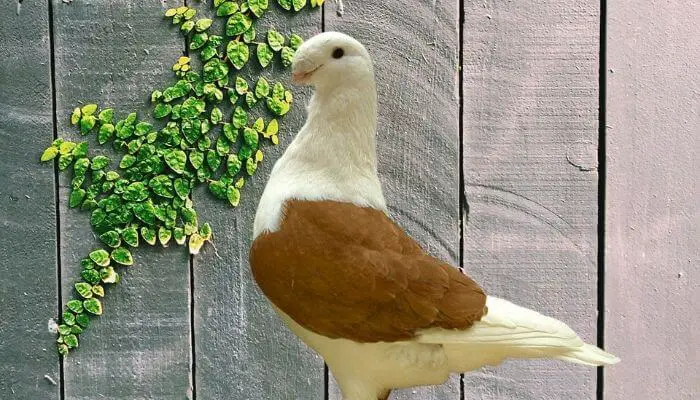The Antwerp Smerle was one of the main pigeons that was used to breed the common homing pigeon.
Known for their distinctive color patterns and fancy beaks, they are a fancy pigeon, highly domesticated, and have slightly above average intelligence when compared to other pigeons.

Antwerp Smerle Origins
It is believed that the bird started out centuries ago in Belgium and was first mentioned in the latter half of the 19th century, due to being seen in various regions of Antwerp.
The Antwerp Smerle were originally classified in England in the 1920’s at a Belgian exhibition.
The Smerle pigeon was imported into Britain but English breeders were not overly enamored with the head which was closer in style, type and size to its wild cousins.
The Belgian breed was selectively cross-bred with the Turbit pigeon to create a better head and beak. The British Antwerp Smerle Club was formed in 1932.
The United States tried to bring the original breed back to increase the existing gene pool.
By crossing a Turbit with a racing pigeon they succeeded in doing this, but the Antwerp Smerle is still a rare breed to come by in the United States.
The US Breed Group for this bird is “flying” and this pigeon is classed as a fancy pigeon.
Antwerp Smerle Appearance
This fancy pigeon is small in size like a racing homer. The hens weigh around 10.05 ounces, while the cocks are 11.25 ounces.
An Antwerp Smerle pigeon’s build is stocky with a bit of an upright body position (characteristics seen in pigeons such as the german owl and chinese owl pigeons) and a round head with dark eyes.
They look extremely similar to the Aachen Lacquer Shield Owl Pigeon.
They are noted for the feathers in the shape of a tie/jabot growing down the front of its neck. It has a short beak that is enlarged at the base, and its mouth lines are clearly visible.
They have a small cobby shape to them with a V of colour (including white) on the nape of the neck.
Most of these types of pigeon have a white body, head, tail, legs and perhaps even a white breast.
The wings can be blue, cream, silver, yellow, black or red.
There is a bit of room for variety; some have colors that spread beyond their wings and onto their chest and neck.
Its frilly front sometimes appears and sometimes doesn’t, but even a bird without a frilly feather front may still be an Antwerp Smerle.
Their Curved Beak
The fanciest features of the Antwerp Smerle have to be its beak, because it is small and looks more like a baby parrot’s beak and the marking and colours of their wings which are very rich and bright.
The baby has what looks like a slightly misshapen beak, and this grows so that there is what looks like a hood above the beak, which is often covered in fluffy feathers.
The beak is short with an enlargement at the base that is made to look all the bigger thanks to the fluffy hood. Due to the way its feathers grow, it has very visible mouth lines.
The ones without a fluffy hood over their beaks look a little more slender when they are being held.
Some Antwerp Smerle pigeons do not have a very visible hood over their beak, some do not have the frilly chest, but they are still classified as an Antwerp Smerle pigeon if they conform to the other characteristics of the breed.
Breeding Antwerp Smerles
To breed this type of pigeon, you will need a dry coop that will protect it from all weather.
You will need to make sure you know which is female and male, so you can separate them, or mix them if you want to mate them.
If the bird needs a fly pen, you will need to get one that will dry out fast.
You will need nesting materials that are safe to use for pigeons, water that is safe for human consumption, and the breeding area will need to be protected at all times from flying and walking predators.
When breeding, you will need both mineral and feed rations that are safe from contamination.
Antwerp Smerle Character
If it is normalised at an early age, then it is fairly tame and domesticated.
If they are tamed, then they do not mind being around people, and some very domesticated Antwerp Smerle pigeons show higher-than-average intelligence, from being able to recognize the emotions of a human to being able to recognize themselves in a mirror (rather than thinking it is another bird-like budgies do).
They have a similar personality to homing pigeons, albeit far more domesticated, and probably wouldn’t survive as well out in the wilds on their own if they have been brought up in captivity.
They require very little grooming if their areas are cleaned out regularly enough.
Resources:
